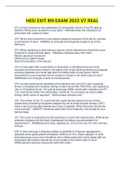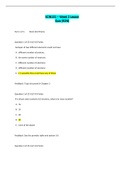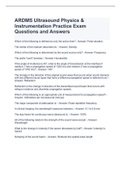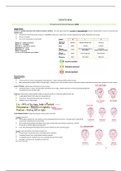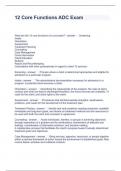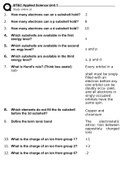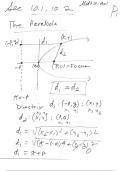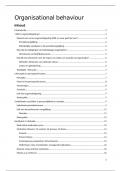READINGS FOR ECON MIDTERM
Chapter 2: Absolute Advantage
- Absolute advantage = one country can produce a product more cheaply than another, thus, that country will
export to another country
- a one-product model: makes it want to export, because it can gain profits from exporting
- might be caused by better technology or ground conditions, absolute advantage reflects the differences in
supply conditions in two countries
- Differences in supply conditions among the countries of the world can give rise to complementary patterns
of absolute advantage. These patterns of absolute advantage, in turn, make possible complementary patterns
of international trade
- Limitations of absolute advantage model = suggest possibility that a country could not have an absolute
advantage in anything, therefore would not export anything → this is unlikely
- Superior technology in a sector and / or larger endowments of factors used in a sector (lower input prices)
→ absolute advantage in a sector → tendency to export the sector’s product
- Inferior technology in a sector and / or endowments of factors used in a sector (higher input prices) →
absolute disadvantage in a sector → tendency to import the sector’s product
- in this model demand assumed to be the same
- Differences in supply arising from different factor endowments
Chapter 3: Comparative Advantage (ricardian model)
- Technology conditions give a country a Production possibility frontier (PPF) that is biased towards a
certain thing
- PPF: tradeoff that countries must make in order to produce one unit, in terms of another
- While one country might be better at producing one thing, another might be better at producing another, due
to their different PPFs
- Opportunity Cost = shown by slope of PPF = how many of one thing must be given up, to produce another
- Tangency line that gives relative prices shows opportunity cost = thus if this is lower, a country has a
comparative advantage
- Differences in economy-wide supply conditions cause differences in relative autarky prices = shows pattern
of comparative advantage = this makes trade possible
- Moving from autarky to trade restructures an economy’s production toward the good in which the country
has a comparative advantage
- Differences in technology and/or factor endowments among the countries of the world can generate patterns
of comparative advantage. Although patterns of comparative advantage can be influenced by patterns of
absolute advantage, they are not determined by patterns of absolute advantage. Indeed, a country can have a
comparative advantage in a good in which it has an absolute disadvantage. Patterns of comparative
advantage determine patterns of trade in the world economy and generate mutual gains from trade.
- model with two products
Chapter 4: Intra-Industry trade
- Inter-industry = a country either imports or exports a given product → either / or (source: comparative
advantage)
- Intra-industry = both / and
- Two types of intra-industry trade
1. horizontal intra-industry trade and its source in product differentiation = (horizontal refers to the
fact that the products exchanged are at the same level of processing→ both the exported variety
and the imported variety are final goods)
2. vertical intra-industry trade = source in fragmentation (comp. adv. In some instances) ex: china
imports computer components and assembles them into final product → imported computer
components are at a previous stage of processing than exported computers, but from POV of
computer products, this is intra-industry trade → this fragmentation of production processes is part
of international production = windows of international trade and production interact in an
important way here → some part of the fragmentation is comparative advantage working in a new
way within in the realm of parts and components rather than final goods
global patterns of intra-industry trade:
,- increase intra-industry trade that is based on absolute or comparative advantage involves import sectors
contracting and export sectors expanding → requires that productive resources (workers, etc) shift from
contracting to expanding sectors in order to avoid unemployment
- adjustment process: a given sector experiences increases in imports and exports simultaneously → workers
are less likely to need to shift between sectors of their home economy
- in case of horizontal intra-industry trade: labour market adjustment is across product market niches
- in case of vertical intra-industry trade: labour market adjustment is across tasks or stages of production
- smooth adjustment hypothesis = potential for intra-industry trade to provide smoother trade trajectories
form an adjustment POV
- rank smoothness of adjustment across three types of trade:
1. inter-industry trade: low (not at all smooth)
2. vertical intra-industry trade: medium (somewhat smooth)
3. horizontal intra-industry trade: high (smooth)
Chapter 7: The World Trade Organization
- GATT (General Agreement on Tariffs and Trade):
1. important principle = nondiscrimination; subprinciples = most favored nation & national treatment
- Most Favored Nation (MFN): each member must grant treatment to all other members as favorable as it
extends to any individual member country & has special importance for developing countries, because they
will benefit from tariff reductions negotiated among developed countries // exceptions: in case of certain
preferential trade agreements → border issues
- National Treatment (NT): addresses internal, domestic polices such as taxes & specifies that foreign goods
within a country should be treated no less favorably than domestic goods with regard to tax policies and
other regulations
- MFN & NT = Nondiscrimination Principle
2. important principle: general prohibition of quotas or quantitative restrictions on trade → reflects
longstanding view that price distortions (tariffs) are preferred to quantity distortions in
international markets
3. important principle: binding: GATT- and WTO-sponsored reductions in tariff levels have been
based on the practice of binding tariffs at agreed- upon levels, often above applied levels. Once set,
tariff bindings may not in general be increased in the future. Applied rates that are below bound
rates, however, may be increased. → purpose = introduce a degree of predictability into the wolrd
trading system
4. important principle: fair trade: promoting fair competition, GATT introduced a number of
stipulations with regard to subsidies, countervailing duties (CVD), and antidumping duties (AD), if
this causes ‘material injury’ or ‘threat thereof’, the other country must apply countervailing duties
or tariffs on its imports of the products from the subsidizing country
- The purpose of GATT is to promote international trade, reducing costs, reducing non-tariff measures,
which are a combination of hidden costs and absolute obstacles
Trade in Goods:
- Tariffication = conversion of quotas into equivalent tariffs
- Green box measures: non-trade-distorting policies, exempt from any reduction commitments
- Amber box measures: trade-distorting policies, not exempt, these commitments are specified in terms of
what are known as ‘total aggregate measures of support’
Trade in Services:
- General Agreement on Trade in Services (GATS) represents the first time that services have been brought
into a multilateral trade agreement.
, - To provide a structure to trade in services, GATS defined trade in services as occurring in one of four
modes:
1. Cross-border trade is a mode of supply that does not require the physical movement of producers
or consumer
2. Movement of consumers involves the consumer traveling to the country of the producer and is
typical of the consumption of tourism services
3. Commercial presence or FDI is involved for services that require a commercial presence by
producers in the country of the consumers and is typical of financial services.
4. movement of natural persons involves a noncommercial presence by producers to supply
consulting, construction, and instructional services
- negative list: each member was allowed to specify nondiscrimination exemptions on a negative list of
sectors upon entry into the agreement that lasted 10 years
- positive list: for those sectors a member country specifies on a positive list, the GATS prohibits certain
market aces restrictions
- types of limitations were prohibited: the number of service suppliers, the total value of service transactions,
the total number of operations or quantity of output, number of personnel employed, the type of legal entity
in the case of FDI, and the share of foreign ownership in the case of FDI
Intellectual Property (IP):
- Trade-related Aspects of Intellectual Property Rights (TRIPS): IP is an asset in form of rights conferred on
a product of invention or creation by a country’s legal system
- TRIPS agreement defined intellectual property as belonging to any of six categories: copyrights,
trademarks, geographical indications, industrial designs, patents, and layout designs of integrated circuits. It
is thus quite comprehensive
- The trade-relatedness of IP refers to the fact that “theft” of intellectual property suppresses trade of the
goods in question
The TRIPS agreement sets out obligations for members around six IP categories:
1. Copyrights. Members must comply with the 1971 Berne Convention on copy- rights. Computer
programs are protected as literary works under the Berne con- vention, and the unauthorized recording
of live broadcasts and performances is prohibited. The term of this protection is to be 50 years.
2. Trademarks. Trademarks of goods and services are to be protected for a term of no less than seven
years. Provisions for the registration of trademarks must be made and are renewable indefinitely.
3. Geographical indications. Members must provide legal means to prevent the false use of geographical
indications.
4. Industrial designs. Members must protect “independently created industrial designs that are new or
original.” This protection does not apply to “designs dictated essentially by technical or functional
considerations.” The protection of industrial designs must last at least 10 years.
5. Patents. The Agreement states, “patents shall be available for any inventions, whether products or
processes, in all fields of technology, provided that they are new, involve an inventive step and are
capable of industrial application.” Exceptions to this do exist and include the protection of public order,
and human, animal, and plant life. Patents are to be extended for at least 20 years, representing a
harmonization to the high-income country standard.
6. Layout designs of integrated circuits. The distribution of protected layout designs, as well as integrated
circuits embodying protected layout designs, is forbidden. This protection is to extend for at least 10
years.
Conclusion:
- WTO completed Bretton Woods vision of global trade institution
- Demonstrates importance of multilateral approaches to managing trade issues
- Common fault line exists across many issues within the WTO between developed and developing countries
- With regard to the old GATT agenda of trade in goods, developing countries are still at a market access
disadvantage in textiles, clothing, and agriculture
- In the short term, developing countries will generally lose from intellectual property protection through the
higher prices they will have to pay for goods and services. This short-term cost will have to be accepted by
the developing world, waiting for the hoped-for, long-term benefits of increased inward FDI and domestic
innovation
Chapter 2: Absolute Advantage
- Absolute advantage = one country can produce a product more cheaply than another, thus, that country will
export to another country
- a one-product model: makes it want to export, because it can gain profits from exporting
- might be caused by better technology or ground conditions, absolute advantage reflects the differences in
supply conditions in two countries
- Differences in supply conditions among the countries of the world can give rise to complementary patterns
of absolute advantage. These patterns of absolute advantage, in turn, make possible complementary patterns
of international trade
- Limitations of absolute advantage model = suggest possibility that a country could not have an absolute
advantage in anything, therefore would not export anything → this is unlikely
- Superior technology in a sector and / or larger endowments of factors used in a sector (lower input prices)
→ absolute advantage in a sector → tendency to export the sector’s product
- Inferior technology in a sector and / or endowments of factors used in a sector (higher input prices) →
absolute disadvantage in a sector → tendency to import the sector’s product
- in this model demand assumed to be the same
- Differences in supply arising from different factor endowments
Chapter 3: Comparative Advantage (ricardian model)
- Technology conditions give a country a Production possibility frontier (PPF) that is biased towards a
certain thing
- PPF: tradeoff that countries must make in order to produce one unit, in terms of another
- While one country might be better at producing one thing, another might be better at producing another, due
to their different PPFs
- Opportunity Cost = shown by slope of PPF = how many of one thing must be given up, to produce another
- Tangency line that gives relative prices shows opportunity cost = thus if this is lower, a country has a
comparative advantage
- Differences in economy-wide supply conditions cause differences in relative autarky prices = shows pattern
of comparative advantage = this makes trade possible
- Moving from autarky to trade restructures an economy’s production toward the good in which the country
has a comparative advantage
- Differences in technology and/or factor endowments among the countries of the world can generate patterns
of comparative advantage. Although patterns of comparative advantage can be influenced by patterns of
absolute advantage, they are not determined by patterns of absolute advantage. Indeed, a country can have a
comparative advantage in a good in which it has an absolute disadvantage. Patterns of comparative
advantage determine patterns of trade in the world economy and generate mutual gains from trade.
- model with two products
Chapter 4: Intra-Industry trade
- Inter-industry = a country either imports or exports a given product → either / or (source: comparative
advantage)
- Intra-industry = both / and
- Two types of intra-industry trade
1. horizontal intra-industry trade and its source in product differentiation = (horizontal refers to the
fact that the products exchanged are at the same level of processing→ both the exported variety
and the imported variety are final goods)
2. vertical intra-industry trade = source in fragmentation (comp. adv. In some instances) ex: china
imports computer components and assembles them into final product → imported computer
components are at a previous stage of processing than exported computers, but from POV of
computer products, this is intra-industry trade → this fragmentation of production processes is part
of international production = windows of international trade and production interact in an
important way here → some part of the fragmentation is comparative advantage working in a new
way within in the realm of parts and components rather than final goods
global patterns of intra-industry trade:
,- increase intra-industry trade that is based on absolute or comparative advantage involves import sectors
contracting and export sectors expanding → requires that productive resources (workers, etc) shift from
contracting to expanding sectors in order to avoid unemployment
- adjustment process: a given sector experiences increases in imports and exports simultaneously → workers
are less likely to need to shift between sectors of their home economy
- in case of horizontal intra-industry trade: labour market adjustment is across product market niches
- in case of vertical intra-industry trade: labour market adjustment is across tasks or stages of production
- smooth adjustment hypothesis = potential for intra-industry trade to provide smoother trade trajectories
form an adjustment POV
- rank smoothness of adjustment across three types of trade:
1. inter-industry trade: low (not at all smooth)
2. vertical intra-industry trade: medium (somewhat smooth)
3. horizontal intra-industry trade: high (smooth)
Chapter 7: The World Trade Organization
- GATT (General Agreement on Tariffs and Trade):
1. important principle = nondiscrimination; subprinciples = most favored nation & national treatment
- Most Favored Nation (MFN): each member must grant treatment to all other members as favorable as it
extends to any individual member country & has special importance for developing countries, because they
will benefit from tariff reductions negotiated among developed countries // exceptions: in case of certain
preferential trade agreements → border issues
- National Treatment (NT): addresses internal, domestic polices such as taxes & specifies that foreign goods
within a country should be treated no less favorably than domestic goods with regard to tax policies and
other regulations
- MFN & NT = Nondiscrimination Principle
2. important principle: general prohibition of quotas or quantitative restrictions on trade → reflects
longstanding view that price distortions (tariffs) are preferred to quantity distortions in
international markets
3. important principle: binding: GATT- and WTO-sponsored reductions in tariff levels have been
based on the practice of binding tariffs at agreed- upon levels, often above applied levels. Once set,
tariff bindings may not in general be increased in the future. Applied rates that are below bound
rates, however, may be increased. → purpose = introduce a degree of predictability into the wolrd
trading system
4. important principle: fair trade: promoting fair competition, GATT introduced a number of
stipulations with regard to subsidies, countervailing duties (CVD), and antidumping duties (AD), if
this causes ‘material injury’ or ‘threat thereof’, the other country must apply countervailing duties
or tariffs on its imports of the products from the subsidizing country
- The purpose of GATT is to promote international trade, reducing costs, reducing non-tariff measures,
which are a combination of hidden costs and absolute obstacles
Trade in Goods:
- Tariffication = conversion of quotas into equivalent tariffs
- Green box measures: non-trade-distorting policies, exempt from any reduction commitments
- Amber box measures: trade-distorting policies, not exempt, these commitments are specified in terms of
what are known as ‘total aggregate measures of support’
Trade in Services:
- General Agreement on Trade in Services (GATS) represents the first time that services have been brought
into a multilateral trade agreement.
, - To provide a structure to trade in services, GATS defined trade in services as occurring in one of four
modes:
1. Cross-border trade is a mode of supply that does not require the physical movement of producers
or consumer
2. Movement of consumers involves the consumer traveling to the country of the producer and is
typical of the consumption of tourism services
3. Commercial presence or FDI is involved for services that require a commercial presence by
producers in the country of the consumers and is typical of financial services.
4. movement of natural persons involves a noncommercial presence by producers to supply
consulting, construction, and instructional services
- negative list: each member was allowed to specify nondiscrimination exemptions on a negative list of
sectors upon entry into the agreement that lasted 10 years
- positive list: for those sectors a member country specifies on a positive list, the GATS prohibits certain
market aces restrictions
- types of limitations were prohibited: the number of service suppliers, the total value of service transactions,
the total number of operations or quantity of output, number of personnel employed, the type of legal entity
in the case of FDI, and the share of foreign ownership in the case of FDI
Intellectual Property (IP):
- Trade-related Aspects of Intellectual Property Rights (TRIPS): IP is an asset in form of rights conferred on
a product of invention or creation by a country’s legal system
- TRIPS agreement defined intellectual property as belonging to any of six categories: copyrights,
trademarks, geographical indications, industrial designs, patents, and layout designs of integrated circuits. It
is thus quite comprehensive
- The trade-relatedness of IP refers to the fact that “theft” of intellectual property suppresses trade of the
goods in question
The TRIPS agreement sets out obligations for members around six IP categories:
1. Copyrights. Members must comply with the 1971 Berne Convention on copy- rights. Computer
programs are protected as literary works under the Berne con- vention, and the unauthorized recording
of live broadcasts and performances is prohibited. The term of this protection is to be 50 years.
2. Trademarks. Trademarks of goods and services are to be protected for a term of no less than seven
years. Provisions for the registration of trademarks must be made and are renewable indefinitely.
3. Geographical indications. Members must provide legal means to prevent the false use of geographical
indications.
4. Industrial designs. Members must protect “independently created industrial designs that are new or
original.” This protection does not apply to “designs dictated essentially by technical or functional
considerations.” The protection of industrial designs must last at least 10 years.
5. Patents. The Agreement states, “patents shall be available for any inventions, whether products or
processes, in all fields of technology, provided that they are new, involve an inventive step and are
capable of industrial application.” Exceptions to this do exist and include the protection of public order,
and human, animal, and plant life. Patents are to be extended for at least 20 years, representing a
harmonization to the high-income country standard.
6. Layout designs of integrated circuits. The distribution of protected layout designs, as well as integrated
circuits embodying protected layout designs, is forbidden. This protection is to extend for at least 10
years.
Conclusion:
- WTO completed Bretton Woods vision of global trade institution
- Demonstrates importance of multilateral approaches to managing trade issues
- Common fault line exists across many issues within the WTO between developed and developing countries
- With regard to the old GATT agenda of trade in goods, developing countries are still at a market access
disadvantage in textiles, clothing, and agriculture
- In the short term, developing countries will generally lose from intellectual property protection through the
higher prices they will have to pay for goods and services. This short-term cost will have to be accepted by
the developing world, waiting for the hoped-for, long-term benefits of increased inward FDI and domestic
innovation



